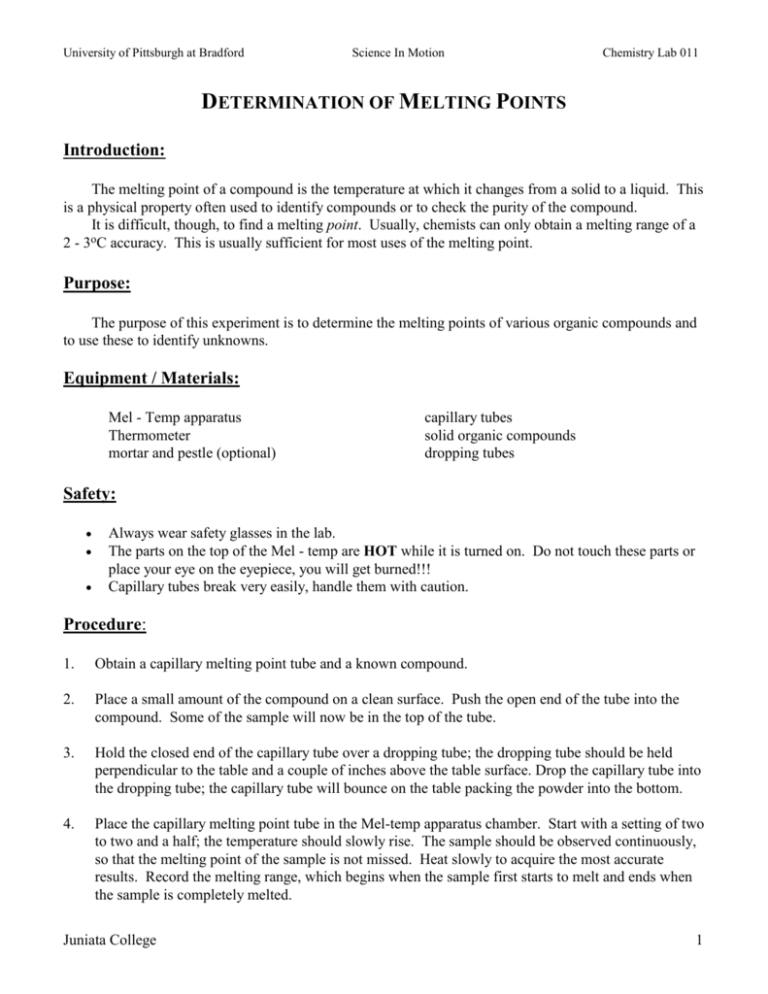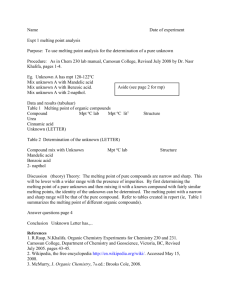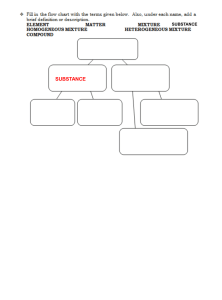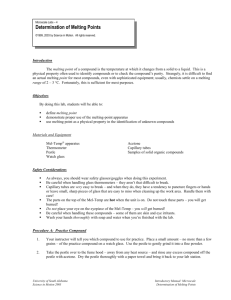DETERMINATION OF MELTING POINTS
advertisement

University of Pittsburgh at Bradford Science In Motion Chemistry Lab 011 DETERMINATION OF MELTING POINTS Introduction: The melting point of a compound is the temperature at which it changes from a solid to a liquid. This is a physical property often used to identify compounds or to check the purity of the compound. It is difficult, though, to find a melting point. Usually, chemists can only obtain a melting range of a o 2 - 3 C accuracy. This is usually sufficient for most uses of the melting point. Purpose: The purpose of this experiment is to determine the melting points of various organic compounds and to use these to identify unknowns. Equipment / Materials: Mel - Temp apparatus Thermometer mortar and pestle (optional) capillary tubes solid organic compounds dropping tubes Safety: Always wear safety glasses in the lab. The parts on the top of the Mel - temp are HOT while it is turned on. Do not touch these parts or place your eye on the eyepiece, you will get burned!!! Capillary tubes break very easily, handle them with caution. Procedure: 1. Obtain a capillary melting point tube and a known compound. 2. Place a small amount of the compound on a clean surface. Push the open end of the tube into the compound. Some of the sample will now be in the top of the tube. 3. Hold the closed end of the capillary tube over a dropping tube; the dropping tube should be held perpendicular to the table and a couple of inches above the table surface. Drop the capillary tube into the dropping tube; the capillary tube will bounce on the table packing the powder into the bottom. 4. Place the capillary melting point tube in the Mel-temp apparatus chamber. Start with a setting of two to two and a half; the temperature should slowly rise. The sample should be observed continuously, so that the melting point of the sample is not missed. Heat slowly to acquire the most accurate results. Record the melting range, which begins when the sample first starts to melt and ends when the sample is completely melted. Juniata College 1 5. Allow the Mel-Temp to cool. Obtain an unknown sample and determine its melting range. Identify the unknown by comparing the data of the knowns the class has obtained. 6. Time permitting, pulverize a mixture of two known substances used for practice with a mortar and pestle and determine the melting point of the mixture. Data Table: Known Compounds: melting range compound - o - o - o C melting range compound C Unknown: melting range compound Unknown # ___________ C identity of compound (OPTIONAL) Melting points of mixture _______: _________C and _________C Components of mixture _______ are ________________________and ________________________ Questions: 1. Define the "melting point" of a substance. 2. What is the purpose of determining melting points? 3. Why is this method not used for finding the melting points of inorganic compounds? 4. Why could the rate of heating influence the melting point? Juniata College 2









